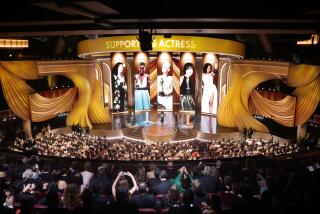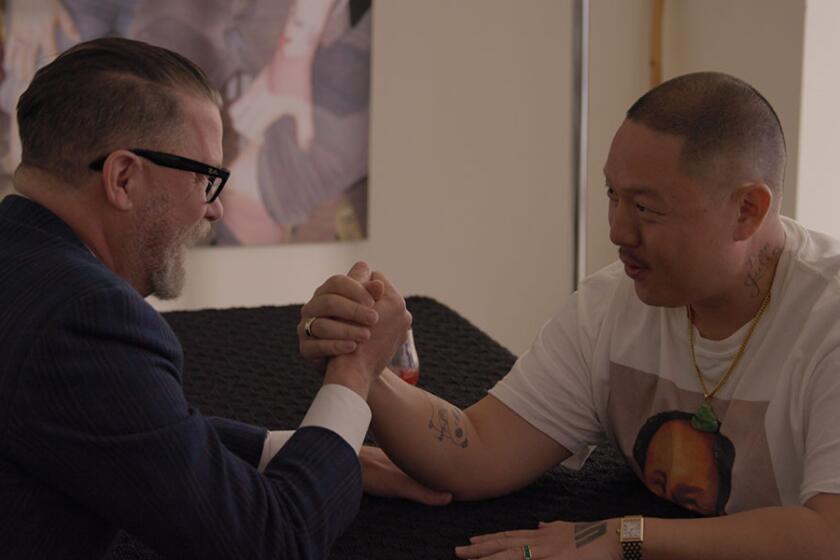New academy president David Rubin on diversity, the Academy Museum and dealing with controversy
Once upon a time in Hollywood, being president of the Academy of Motion Picture Arts and Sciences was a pretty stress-free, largely ceremonial gig. But times have changed, and casting director David Rubin, who was elected Tuesday evening to lead an organization in the midst of an ongoing transformation, may not get much of a honeymoon period.
Taking over from outgoing president John Bailey, whose two-year tenure was punctuated by a string of controversies, Rubin has inherited a range of thorny issues facing the 92-year-old institution, from an ambitious museum project that has faced cost overruns and delays to flagging ratings for the Oscars telecast, which hit an all-time low in 2018, to seismic shifts in the way people watch and define movies.
The Times spoke by phone with Rubin, whose numerous credits include “Men in Black,” “Gravity” and HBO’s “Big Little Lies,” about where the academy is headed and how he plans to tackle some of its most significant challenges.
The academy has changed dramatically in the past several years. The voting membership has grown by more than 50% since 2012 and has become more international and more diverse. What is your overall sense of the state of the academy today and how it’s changed since you first joined the board of governors six years ago?
I don’t really think about the academy in terms of the size of its membership so much as the composition of its membership. Because I think what’s happened in the last several years is a parallel in the academy’s membership to what the world looks like and what the world of filmmaking looks like. Our efforts to increase the number of women and people of color in the academy, which have been tremendously successful, are creating in many ways a change of culture in the academy. And that’s what we hoped would be achieved.
The academy appears to be on track to meet the goal it set out in 2016 to double the number of women and people of color in the organization by 2020. But looking beyond those benchmarks, how will we see the push toward inclusion continue going forward?
We’re going to be promoting our various initiatives to engage more people in the film community, because the way you encourage the future members of the academy is to provide opportunities to women and to people of color. And we’re doing that through various initiatives: the Academy Women’s Initiative, which really empowers women in the global community by hosting events all over the world designed to increase opportunities for women, and the Academy Gold program, which is this amazing internship and mentorship program for college-age students.
I’m also hoping that the academy can exert some influence over studios and production companies and filmmakers to encourage them to offer opportunities to people of color and to women because that’s how you encourage talent and that’s the next generation of brilliant storytellers. It’s not only about numbers. It’s about the changing of culture.
The opening of the Academy Museum was recently pushed back again, to next year, and just a couple of days ago we learned that museum director Kerry Brougher is leaving the project. Can you shed any light on what happened with Brougher, and are you confident that the museum is where it needs to be in terms of construction and fundraising and everything else?
Everything is on track, and Kerry Brougher contributed tremendously to getting us there. I think the business of opening the museum has to do with when we’re all satisfied that this is a world-class museum that represents all facets of the academy. And just like the release of a film, we will choose the right moment for our opening and announce it when the time is right.
When the idea of creating a “best popular film” Oscar was proposed last year, there was immediate blowback and the proposal was shelved. But at the same time, the academy does need to figure out how to get people more engaged with the Academy Awards. Could we see the “popular film” idea being revived in some form, or are there other things you think would help boost public interest in the show?
We’re always discussing and are always open to new ideas in terms of engaging our audience for the Oscars, although I think we also each year rely on how the crop of movies captivates the audience and we work as hard as we can to promote the way those movies have connected in order to ensure that we have engagement from our viewers. So I wouldn’t take anything off the table except to say that we’re always open to exploring ways of connecting with the audience in our partnership with ABC.
At the same time, the academy is trying to wrestle with deeper changes in how people are watching movies. As the audience shifts more and more toward streaming and the boundary between TV and film continues to blur, there are some people who think the academy needs to hold the line to preserve the traditional moviegoing experience and others who think it should roll with the changes. You’ve worked in both film and television. Where do you come down?
I come down in feeling as though it’s not an either/or proposition. I would always want to protect and promote the joys of sitting in a packed theater and staring up at that screen, and I also understand that audiences of all generations are watching stories in many, many different formats.
One of the things I’m looking most forward to in the coming year is to hopefully assemble the best and brightest of our colleagues in an effort to address the question: What is a motion picture? Because I think we’re all grappling with a changing landscape, and I think it’s exciting to try to define those things so that we all know how we’re rewarding excellence. But I don’t see it as an either/or. I see it as a dialogue that’s about to happen and it would be great if we could come to some agreement on that.
You’re the first casting director to serve as academy president. There’s never been a competitive Academy Award for casting, and casting directors have only had their own branch since 2013. Is an Oscar category for casting something you’d be interested in exploring?
My involvement with the academy has not been focused on that per se. It has really been about promoting the academy’s mission in general. Of course, I’m thrilled to read that [the British Academy] this morning announced an upcoming casting award in 2020 and I’m also obviously thrilled as a representative of the casting directors branch to have been elected president of the academy. It will likely serve to increase awareness of our involvement in the collaborative art of filmmaking. But other than that, I would say let’s just see what the future brings.
The academy is under a much more intense microscope than it used to be, and we’ve seen that a lot of people are ready to jump on it for perceived missteps and that controversies can quickly blow up on social media. Why do you think that is, and what are you prepared to do to help improve the academy’s image overall?
I’m very interested in providing context for the decisions that the academy makes. I think where misunderstandings occur are when not enough detail is provided, when there’s not enough communication with our members and the press. I would be interested in assuring that people understand where the well-intentioned work of the academy comes from, as opposed to necessarily just announcing conclusions, because I think that is where misunderstandings and misperceptions arise. So I think correct and complete messaging is key to have buy-in from our members on the hard work that the academy board is doing.
More to Read
Only good movies
Get the Indie Focus newsletter, Mark Olsen's weekly guide to the world of cinema.
You may occasionally receive promotional content from the Los Angeles Times.











